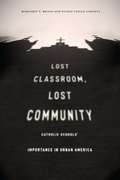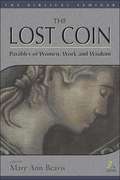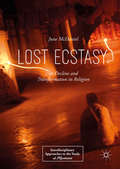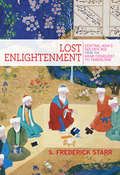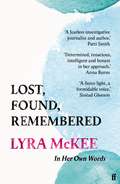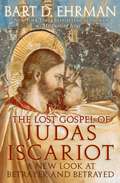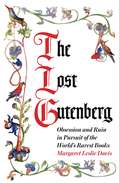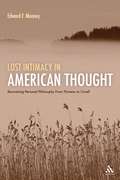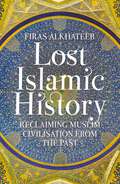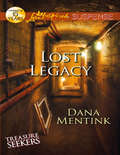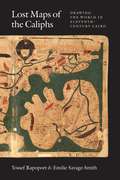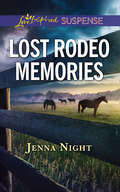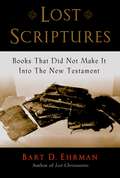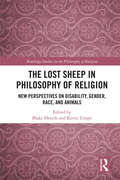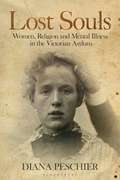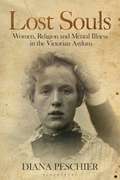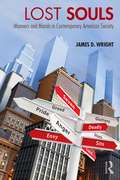- Table View
- List View
Lost Classroom, Lost Community: Catholic Schools' Importance in Urban America
by Margaret F. Brinig Nicole Stelle GarnettIn the past two decades in the United States, more than 1,600 Catholic elementary and secondary schools have closed, and more than 4,500 charter schools—public schools that are often privately operated and freed from certain regulations—have opened, many in urban areas. With a particular emphasis on Catholic school closures, Lost Classroom, Lost Community examines the implications of these dramatic shifts in the urban educational landscape. More than just educational institutions, Catholic schools promote the development of social capital—the social networks and mutual trust that form the foundation of safe and cohesive communities. Drawing on data from the Project on Human Development in Chicago Neighborhoods and crime reports collected at the police beat or census tract level in Chicago, Philadelphia, and Los Angeles, Margaret F. Brinig and Nicole Stelle Garnett demonstrate that the loss of Catholic schools triggers disorder, crime, and an overall decline in community cohesiveness, and suggest that new charter schools fail to fill the gaps left behind. This book shows that the closing of Catholic schools harms the very communities they were created to bring together and serve, and it will have vital implications for both education and policing policy debates.
The Lost Coin: Parables of Women, Work, and Wisdom (Biblical Seminar)
by Mary Ann BeavisA collection of feminist interpretations of parables about women and women's work. This volume not only fills a gap in the scholarly literature on parables, but brings to life vignettes from ancient Mediterranean women's lives and offer insights into the place of women in the ministry of Jesus, the early church, and Christian theology. It is a rich resource for scholarship, teaching and preaching.Contributors include the editor, Elisabeth Schnssler Fiorenza, Linda Maloney, Kathleen Nash, Pheme Perkins, Barbara Reid, Kathleen Rushton, Holly Hearon, and Adele Reinhartz. Topics include feminist readings of the Parable of the Persistent Widow, the ôWise and Foolish Virgins,ö the Prodigal Son, the Faithful Steward, and the ôBrideö in John 3.
Lost Ecstasy: Its Decline and Transformation in Religion (Interdisciplinary Approaches to the Study of Mysticism)
by June McDanielThis book is a study of religious ecstasy, and the ways that it has been suppressed in both the academic study of religion, and in much of the modern practice of religion. It examines the meanings of the term, how ecstatic experience is understood in a range of religions, and why the importance of religious and mystical ecstasy has declined in the modern West. June McDaniel examines how the search for ecstatic experience has migrated into such areas as war, terrorism, transgression, sexuality, drug use, and anti-institutional forms of spirituality. She argues that the loss of religious and mystical ecstasy, as both a religious goal and as a topic of academic study, has had wide-ranging negative effects. She also proposes that the field of religious studies must go beyond criminalizing, trivializing and pathologizing ecstatic and mystical experiences. Both religious studies and theology need to take these states seriously as important aspects of lived human experience.
Lost Ecstasy: Its Decline and Transformation in Religion (Interdisciplinary Approaches to the Study of Mysticism)
by June McDanielThis book is a study of religious ecstasy, and the ways that it has been suppressed in both the academic study of religion, and in much of the modern practice of religion. It examines the meanings of the term, how ecstatic experience is understood in a range of religions, and why the importance of religious and mystical ecstasy has declined in the modern West. June McDaniel examines how the search for ecstatic experience has migrated into such areas as war, terrorism, transgression, sexuality, drug use, and anti-institutional forms of spirituality. She argues that the loss of religious and mystical ecstasy, as both a religious goal and as a topic of academic study, has had wide-ranging negative effects. She also proposes that the field of religious studies must go beyond criminalizing, trivializing and pathologizing ecstatic and mystical experiences. Both religious studies and theology need to take these states seriously as important aspects of lived human experience.
Lost Enlightenment: Central Asia's Golden Age from the Arab Conquest to Tamerlane
by S. Frederick StarrIn this sweeping and richly illustrated history, S. Frederick Starr tells the fascinating but largely unknown story of Central Asia's medieval enlightenment through the eventful lives and astonishing accomplishments of its greatest minds--remarkable figures who built a bridge to the modern world. Because nearly all of these figures wrote in Arabic, they were long assumed to have been Arabs. In fact, they were from Central Asia--drawn from the Persianate and Turkic peoples of a region that today extends from Kazakhstan southward through Afghanistan, and from the easternmost province of Iran through Xinjiang, China. Lost Enlightenment recounts how, between the years 800 and 1200, Central Asia led the world in trade and economic development, the size and sophistication of its cities, the refinement of its arts, and, above all, in the advancement of knowledge in many fields. Central Asians achieved signal breakthroughs in astronomy, mathematics, geology, medicine, chemistry, music, social science, philosophy, and theology, among other subjects. They gave algebra its name, calculated the earth's diameter with unprecedented precision, wrote the books that later defined European medicine, and penned some of the world's greatest poetry. One scholar, working in Afghanistan, even predicted the existence of North and South America--five centuries before Columbus. Rarely in history has a more impressive group of polymaths appeared at one place and time. No wonder that their writings influenced European culture from the time of St. Thomas Aquinas down to the scientific revolution, and had a similarly deep impact in India and much of Asia. Lost Enlightenment chronicles this forgotten age of achievement, seeks to explain its rise, and explores the competing theories about the cause of its eventual demise. Informed by the latest scholarship yet written in a lively and accessible style, this is a book that will surprise general readers and specialists alike.
Lost, Found, Remembered
by Lyra McKee'Determined, tenacious, intelligent, and honest in her approach.' - Anna BurnsWhen the Northern Irish journalist Lyra McKee was murdered in Derry in April 2019 aged just 29, she was survived by her articles that had been read and loved by thousands worldwide.This memorial anthology will weave together the pieces that defined her reputation as one of the most important and formidable investigative journalists of her generation. It showcases the expansive breadth of McKee's voice by bringing together unpublished material alongside both her celebrated and lesser-known articles. Released in time for the anniversary of her death, it reveals the sheer scope of McKee's intellectual, political, and radically humane engagement with the world - and lets her spirit live on in her own words.
The Lost Gospel of Judas Iscariot: A New Look at Betrayer and Betrayed
by Bart D. EhrmanThe recent National Geographic special on the Gospel of Judas was a major media event, introducing to tens of millions of viewers one of the most important biblical discoveries of modern times. Now, a leading historian of the early church, Bart Ehrman, offers the first comprehensive account of the newly discovered Gospel of Judas, revealing what this legendary lost gospel contains and why it is so important for our understanding of Christianity. Ehrman, a featured commentator in the National Geographic special, describes how he first saw the Gospel of Judas--surprisingly, in a small room above a pizza parlor in a Swiss town near Lake Geneva--and he recounts the fascinating story of where and how this ancient papyrus document was discovered, how it moved around among antiquities dealers in Egypt, the United States, and Switzerland, and how it came to be restored and translated. More important, Ehrman gives the reader a complete and clear account of what the book teaches and he shows how it relates to other Gospel texts--both those inside the New Testament and those outside of it, most notably, the Gnostic texts of early Christianity. Finally, he describes what we now can say about the historical Judas himself as well as his relationship with Jesus, suggesting that one needs to read between the lines of the early Gospels to see exactly what Judas did and why he did it. The Gospel of Judas presents an entirely new view of Jesus, his disciples, and the man who allegedly betrayed him. It raises many questions and Bart Ehrman provides illuminating and authoritative answers, in a book that will interest anyone curious about the New Testament, the life of Jesus, and the history of Christianity after his death.
The Lost Gospel of Judas Iscariot: A New Look at Betrayer and Betrayed
by Bart D. EhrmanThe recent National Geographic special on the Gospel of Judas was a major media event, introducing to tens of millions of viewers one of the most important biblical discoveries of modern times. Now, a leading historian of the early church, Bart Ehrman, offers the first comprehensive account of the newly discovered Gospel of Judas, revealing what this legendary lost gospel contains and why it is so important for our understanding of Christianity. Ehrman, a featured commentator in the National Geographic special, describes how he first saw the Gospel of Judas--surprisingly, in a small room above a pizza parlor in a Swiss town near Lake Geneva--and he recounts the fascinating story of where and how this ancient papyrus document was discovered, how it moved around among antiquities dealers in Egypt, the United States, and Switzerland, and how it came to be restored and translated. More important, Ehrman gives the reader a complete and clear account of what the book teaches and he shows how it relates to other Gospel texts--both those inside the New Testament and those outside of it, most notably, the Gnostic texts of early Christianity. Finally, he describes what we now can say about the historical Judas himself as well as his relationship with Jesus, suggesting that one needs to read between the lines of the early Gospels to see exactly what Judas did and why he did it. The Gospel of Judas presents an entirely new view of Jesus, his disciples, and the man who allegedly betrayed him. It raises many questions and Bart Ehrman provides illuminating and authoritative answers, in a book that will interest anyone curious about the New Testament, the life of Jesus, and the history of Christianity after his death.
The Lost Gutenberg: The Astounding Story of One Book's Five-Hundred-Year Odyssey
by Margaret Leslie Davis'An entertaining and insightful human story of obsession about books.' Daily Telegraph'A lively tale of historical innovation, the thrill of the bibliophile's hunt, greed and betrayal.' New York TimesThe never-before-told story of one extremely rare copy of the Gutenberg Bible, and its impact on the lives of the fanatical few who were lucky enough to own it.For rare book collectors, an original copy of the Gutenberg Bible - there are only forty-six in existence - is the undisputed gem of any collection. The Lost Gutenberg recounts five centuries in the life of one particular copy of the Bible from its very creation by Johannes Gutenberg in Mainz, Germany, to its ultimate resting place, in a steel vault under the protection of the Japanese government. Margaret Leslie Davis draws readers into this incredible saga, inviting them into the colourful lives of each of its fanatic collectors along the way. Exploring books as objects of desire across centuries, Davis will leave readers not only with a broader understanding of the culture of rare book collectors, but with a deeper awareness of the importance of books in our world.
Lost Intimacy in American Thought: Recovering Personal Philosophy From Thoreau to Cavell
by Edward F. MooneyThis book offers a critique of rationalism in contemporary American thought by recovering a lost tradition of intimacy in American philosophical writing.
Lost Islamic History: Reclaiming Muslim Civilisation from the Past
by Firas AlkhateebIslam has been one of the most powerful religious, social and political forces in history. Over the last 1400 years, from origins in Arabia, a succession of Muslim polities and later empires expanded to control territories and peoples that ultimately stretched from southern France to East Africa and South East Asia. Yet many of the contributions of Muslim thinkers, scientists and theologians, not to mention rulers, statesmen and soldiers, have been occluded. This book rescues from oblivion and neglect some of these personalities and institutions while offering the reader a new narrative of this lost Islamic history. The Umayyads, Abbasids, and Ottomans feature in the story, as do Muslim Spain, the savannah kingdoms of West Africa and the Mughal Empire, along with the later European colonization of Muslim lands and the development of modern nation-states in the Muslim world. Throughout, the impact of Islamic belief on scientific advancement, social structures, and cultural development is given due prominence, and the text is complemented by portraits of key personalities, inventions and little known historical nuggets. The history of Islam and of the world's Muslims brings together diverse peoples, geographies and states, all interwoven into one narrative that begins with Muhammad and continues to this day.
Lost Islamic History: Reclaiming Muslim Civilisation from the Past
by Firas AlkhateebIslam has been one of the most powerful religious, social and political forces in history. Over the last 1400 years, from origins in Arabia, a succession of Muslim polities and later empires expanded to control territories and peoples that ultimately stretched from southern France to East Africa and South East Asia. Yet many of the contributions of Muslim thinkers, scientists and theologians, not to mention rulers, statesmen and soldiers, have been occluded. This book rescues from oblivion and neglect some of these personalities and institutions while offering the reader a new narrative of this lost Islamic history. The Umayyads, Abbasids, and Ottomans feature in the story, as do Muslim Spain, the savannah kingdoms of West Africa and the Mughal Empire, along with the later European colonization of Muslim lands and the development of modern nation-states in the Muslim world. Throughout, the impact of Islamic belief on scientific advancement, social structures, and cultural development is given due prominence, and the text is complemented by portraits of key personalities, inventions and little known historical nuggets. The history of Islam and of the world's Muslims brings together diverse peoples, geographies and states, all interwoven into one narrative that begins with Muhammad and continues to this day.
Lost Legacy (Treasure Seekers #1)
by Dana MentinkHER LAST CHANCE Brooke Ramsey is running out of time. She needs to save her father’s reputation before she loses him to illness. That means finding his missing painting. Fast. Which is why she teams up with Victor Gage, owner of Treasure Seekers agency.
Lost Maps of the Caliphs: Drawing the World in Eleventh-Century Cairo
by Yossef Rapoport Emilie Savage-SmithAbout a millennium ago, in Cairo, an unknown author completed a large and richly illustrated book. In the course of thirty-five chapters, this book guided the reader on a journey from the outermost cosmos and planets to Earth and its lands, islands, features, and inhabitants. This treatise, known as The Book of Curiosities, was unknown to modern scholars until a remarkable manuscript copy surfaced in 2000. Lost Maps of the Caliphs provides the first general overview of The Book of Curiosities and the unique insight it offers into medieval Islamic thought. Opening with an account of the remarkable discovery of the manuscript and its purchase by the Bodleian Library, the authors use The Book of Curiosities to re-evaluate the development of astrology, geography, and cartography in the first four centuries of Islam. Their account assesses the transmission of Late Antique geography to the Islamic world, unearths the logic behind abstract maritime diagrams, and considers the palaces and walls that dominate medieval Islamic plans of towns and ports. Early astronomical maps and drawings demonstrate the medieval understanding of the structure of the cosmos and illustrate the pervasive assumption that almost any visible celestial event had an effect upon life on Earth. Lost Maps of the Caliphs also reconsiders the history of global communication networks at the turn of the previous millennium. It shows the Fatimid Empire, and its capital Cairo, as a global maritime power, with tentacles spanning from the eastern Mediterranean to the Indus Valley and the East African coast. As Lost Maps of the Caliphs makes clear, not only is The Book of Curiosities one of the greatest achievements of medieval mapmaking, it is also a remarkable contribution to the story of Islamic civilization that opens an unexpected window to the medieval Islamic view of the world.
Lost Maps of the Caliphs: Drawing the World in Eleventh-Century Cairo
by Yossef Rapoport Emilie Savage-SmithAbout a millennium ago, in Cairo, an unknown author completed a large and richly illustrated book. In the course of thirty-five chapters, this book guided the reader on a journey from the outermost cosmos and planets to Earth and its lands, islands, features, and inhabitants. This treatise, known as The Book of Curiosities, was unknown to modern scholars until a remarkable manuscript copy surfaced in 2000. Lost Maps of the Caliphs provides the first general overview of The Book of Curiosities and the unique insight it offers into medieval Islamic thought. Opening with an account of the remarkable discovery of the manuscript and its purchase by the Bodleian Library, the authors use The Book of Curiosities to re-evaluate the development of astrology, geography, and cartography in the first four centuries of Islam. Their account assesses the transmission of Late Antique geography to the Islamic world, unearths the logic behind abstract maritime diagrams, and considers the palaces and walls that dominate medieval Islamic plans of towns and ports. Early astronomical maps and drawings demonstrate the medieval understanding of the structure of the cosmos and illustrate the pervasive assumption that almost any visible celestial event had an effect upon life on Earth. Lost Maps of the Caliphs also reconsiders the history of global communication networks at the turn of the previous millennium. It shows the Fatimid Empire, and its capital Cairo, as a global maritime power, with tentacles spanning from the eastern Mediterranean to the Indus Valley and the East African coast. As Lost Maps of the Caliphs makes clear, not only is The Book of Curiosities one of the greatest achievements of medieval mapmaking, it is also a remarkable contribution to the story of Islamic civilization that opens an unexpected window to the medieval Islamic view of the world.
Lost Maps of the Caliphs: Drawing the World in Eleventh-Century Cairo
by Yossef Rapoport Emilie Savage-SmithAbout a millennium ago, in Cairo, an unknown author completed a large and richly illustrated book. In the course of thirty-five chapters, this book guided the reader on a journey from the outermost cosmos and planets to Earth and its lands, islands, features, and inhabitants. This treatise, known as The Book of Curiosities, was unknown to modern scholars until a remarkable manuscript copy surfaced in 2000. Lost Maps of the Caliphs provides the first general overview of The Book of Curiosities and the unique insight it offers into medieval Islamic thought. Opening with an account of the remarkable discovery of the manuscript and its purchase by the Bodleian Library, the authors use The Book of Curiosities to re-evaluate the development of astrology, geography, and cartography in the first four centuries of Islam. Their account assesses the transmission of Late Antique geography to the Islamic world, unearths the logic behind abstract maritime diagrams, and considers the palaces and walls that dominate medieval Islamic plans of towns and ports. Early astronomical maps and drawings demonstrate the medieval understanding of the structure of the cosmos and illustrate the pervasive assumption that almost any visible celestial event had an effect upon life on Earth. Lost Maps of the Caliphs also reconsiders the history of global communication networks at the turn of the previous millennium. It shows the Fatimid Empire, and its capital Cairo, as a global maritime power, with tentacles spanning from the eastern Mediterranean to the Indus Valley and the East African coast. As Lost Maps of the Caliphs makes clear, not only is The Book of Curiosities one of the greatest achievements of medieval mapmaking, it is also a remarkable contribution to the story of Islamic civilization that opens an unexpected window to the medieval Islamic view of the world.
Lost Maps of the Caliphs: Drawing the World in Eleventh-Century Cairo
by Yossef Rapoport Emilie Savage-SmithAbout a millennium ago, in Cairo, an unknown author completed a large and richly illustrated book. In the course of thirty-five chapters, this book guided the reader on a journey from the outermost cosmos and planets to Earth and its lands, islands, features, and inhabitants. This treatise, known as The Book of Curiosities, was unknown to modern scholars until a remarkable manuscript copy surfaced in 2000. Lost Maps of the Caliphs provides the first general overview of The Book of Curiosities and the unique insight it offers into medieval Islamic thought. Opening with an account of the remarkable discovery of the manuscript and its purchase by the Bodleian Library, the authors use The Book of Curiosities to re-evaluate the development of astrology, geography, and cartography in the first four centuries of Islam. Their account assesses the transmission of Late Antique geography to the Islamic world, unearths the logic behind abstract maritime diagrams, and considers the palaces and walls that dominate medieval Islamic plans of towns and ports. Early astronomical maps and drawings demonstrate the medieval understanding of the structure of the cosmos and illustrate the pervasive assumption that almost any visible celestial event had an effect upon life on Earth. Lost Maps of the Caliphs also reconsiders the history of global communication networks at the turn of the previous millennium. It shows the Fatimid Empire, and its capital Cairo, as a global maritime power, with tentacles spanning from the eastern Mediterranean to the Indus Valley and the East African coast. As Lost Maps of the Caliphs makes clear, not only is The Book of Curiosities one of the greatest achievements of medieval mapmaking, it is also a remarkable contribution to the story of Islamic civilization that opens an unexpected window to the medieval Islamic view of the world.
Lost Rodeo Memories (Mills And Boon Love Inspired Suspense Ser.)
by Jenna NightWith a stalker in the shadows… She needs a protector at her side.
Lost Scriptures: Books that Did Not Make It into the New Testament
by Bart D. EhrmanWhile most people think that the twenty-seven books of the New Testament are the only sacred writings of the early Christians, this is not at all the case. A companion volume to Bart Ehrman's Lost Christianities, this book offers an anthology of up-to-date and readable translations of many non-canonical writings from the first centuries after Christ--texts that have been for the most part lost or neglected for almost two millennia. Here is an array of remarkably varied writings from early Christian groups whose visions of Jesus differ dramatically from our contemporary understanding. Readers will find Gospels supposedly authored by the apostle Philip, James the brother of Jesus, Mary Magdalen, and others. There are Acts originally ascribed to John and to Thecla, Paul's female companion; there are Epistles allegedly written by Paul to the Roman philosopher Seneca. And there is an apocalypse by Simon Peter that offers a guided tour of the afterlife, both the glorious ecstasies of the saints and the horrendous torments of the damned, and an Epistle by Titus, a companion of Paul, which argues page after page against sexual love, even within marriage, on the grounds that physical intimacy leads to damnation. In all, the anthology includes fifteen Gospels, five non-canonical Acts of the Apostles, thirteen Epistles, a number of Apocalypses and Secret Books, and several Canon lists. Ehrman has included a general introduction, plus brief introductions to each piece. This important anthology gives readers a vivid picture of the range of beliefs that battled each other in the first centuries of the Christian era.
Lost Scriptures: Books that Did Not Make It into the New Testament
by Bart D. EhrmanWhile most people think that the twenty-seven books of the New Testament are the only sacred writings of the early Christians, this is not at all the case. A companion volume to Bart Ehrman's Lost Christianities, this book offers an anthology of up-to-date and readable translations of many non-canonical writings from the first centuries after Christ--texts that have been for the most part lost or neglected for almost two millennia. Here is an array of remarkably varied writings from early Christian groups whose visions of Jesus differ dramatically from our contemporary understanding. Readers will find Gospels supposedly authored by the apostle Philip, James the brother of Jesus, Mary Magdalen, and others. There are Acts originally ascribed to John and to Thecla, Paul's female companion; there are Epistles allegedly written by Paul to the Roman philosopher Seneca. And there is an apocalypse by Simon Peter that offers a guided tour of the afterlife, both the glorious ecstasies of the saints and the horrendous torments of the damned, and an Epistle by Titus, a companion of Paul, which argues page after page against sexual love, even within marriage, on the grounds that physical intimacy leads to damnation. In all, the anthology includes fifteen Gospels, five non-canonical Acts of the Apostles, thirteen Epistles, a number of Apocalypses and Secret Books, and several Canon lists. Ehrman has included a general introduction, plus brief introductions to each piece. This important anthology gives readers a vivid picture of the range of beliefs that battled each other in the first centuries of the Christian era.
The Lost Sheep in Philosophy of Religion: New Perspectives on Disability, Gender, Race, and Animals (Routledge Studies in the Philosophy of Religion)
by Kevin Timpe Blake HerethContemporary research in philosophy of religion is dominated by traditional problems such as the nature of evil, arguments against theism, issues of foreknowledge and freedom, the divine attributes, and religious pluralism. This volume instead focuses on unrepresented and underrepresented issues in the discipline. The essays address how issues like race, sexual orientation, gender identity, disability, feminist and pantheist conceptions of the divine, and nonhuman animals connect to existing issues in philosophy of religion. By staking out new avenues for future research, this book will be of interest to a wide range of scholars in analytic philosophy of religion and analytic philosophical theology.
The Lost Sheep in Philosophy of Religion: New Perspectives on Disability, Gender, Race, and Animals (Routledge Studies in the Philosophy of Religion)
by Kevin Timpe Blake HerethContemporary research in philosophy of religion is dominated by traditional problems such as the nature of evil, arguments against theism, issues of foreknowledge and freedom, the divine attributes, and religious pluralism. This volume instead focuses on unrepresented and underrepresented issues in the discipline. The essays address how issues like race, sexual orientation, gender identity, disability, feminist and pantheist conceptions of the divine, and nonhuman animals connect to existing issues in philosophy of religion. By staking out new avenues for future research, this book will be of interest to a wide range of scholars in analytic philosophy of religion and analytic philosophical theology.
Lost Souls: Women, Religion and Mental Illness in the Victorian Asylum (International Library Of Historical Studies)
by Diana PeschierHow did the Victorians view mental illness? After discovering the case-notes of women in Victorian asylums, Diana Peschier reveals how mental illness was recorded by both medical practitioners and in the popular literature of the era, and why madness became so closely associated with femininity. Her research reveals the plight of women incarcerated in 19th century asylums, how they became patients, and the ways they were perceived by their family, medical professionals, society and by themselves.
Lost Souls: Women, Religion and Mental Illness in the Victorian Asylum
by Diana PeschierHow did the Victorians view mental illness? After discovering the case-notes of women in Victorian asylums, Diana Peschier reveals how mental illness was recorded by both medical practitioners and in the popular literature of the era, and why madness became so closely associated with femininity. Her research reveals the plight of women incarcerated in 19th century asylums, how they became patients, and the ways they were perceived by their family, medical professionals, society and by themselves.
Lost Souls: Manners and Morals in Contemporary American Society
by James D. WrightWhat is the state of contemporary American morality? From their original conception in Christian scripture to their assimilation into Western culture, the 'Seven Deadly Sins' – lust, greed, envy, pride, and all the rest – have guided human morality, steering human behavior and psychology away from evil and toward a full embrace of the good. But their hold on modern life is increasingly tenuous. Indeed, one may observe that these days, deadly sin is far more common and more commonly practiced than its virtuous counterparts – humility, charity, kindness, industriousness, and chastity. Without greed, there is no economy; without anger, no politics; and without pride and envy, surely less motivation and competition would exist. James D. Wright carefully examines the complexities and ambiguities in modern society in the context of the seven deadly sins and their corresponding virtues. Are we all lost souls, condemned by our immoral deeds, or are the trappings of older sin deteriorating? Is it time, finally, to reconsider the classifications of evil and good? Wright uses each chapter to consider how the social sciences have operationalized each 'sin', how they have been studied, and what lessons have been learned over time. He reviews recent trends and contemplates the societal costs and benefits of the behaviors in question. Lost Souls emerges, then, as a meditation on contemporary sin, concluding that the line between guilt and innocence, right and wrong, is often very thin.
